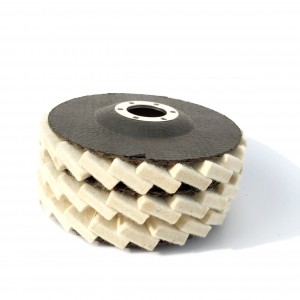In the delicate and meticulous field of cultural heritage restoration, wool felt wheels have emerged as an indispensable tool, playing a crucial role in preserving and rejuvenating historical artifacts and structures. These wheels, with their unique properties, offer a gentle yet effective solution for restoring the original luster and integrity of cultural treasures.
When it comes to restoring ancient sculptures and statues, wool felt wheels are highly valued for their ability to clean and polish surfaces without causing damage. The soft wool fibers can carefully remove layers of dirt, grime, and oxidation that have accumulated over centuries. For instance, in the restoration of marble sculptures, the wool felt wheel can be used to gently buff the surface, bringing back the smooth texture and natural shine. Its gentle action ensures that the intricate details and carvings on the sculptures remain intact, preserving the artistic value of these historical masterpieces.
In the restoration of historical buildings, wool felt wheels are used for a variety of tasks. From polishing the stone facades to refinishing wooden doors and windows, these wheels can handle different materials with ease. When working on stone surfaces, the wool felt wheel can remove weathering and stains, enhancing the aesthetic appeal of the building while also protecting it from further deterioration. For wooden elements, it can be used to apply and buff protective finishes, preventing rot and decay. This not only restores the historical charm of the building but also extends its lifespan, ensuring that it can be enjoyed by future generations.
The use of wool felt wheels in cultural heritage restoration is also significant in the field of manuscript and document preservation. The soft wool fibers can be used to clean delicate paper surfaces, removing dust and debris without causing any tearing or damage. In some cases, the wheels can also be used to apply conservation – grade coatings to protect the documents from environmental factors such as humidity and light. This is particularly important for ancient manuscripts, scrolls, and historical documents that are extremely fragile and require the utmost care.
Moreover, wool felt wheels are often used in combination with other restoration techniques and materials. Conservators may use them in conjunction with specialized cleaning solutions or adhesives to achieve the best results. This combination of traditional and modern methods allows for a more comprehensive and effective restoration process.
As the importance of cultural heritage preservation continues to grow, the role of wool felt wheels in this field is expected to become even more crucial. Their versatility, gentleness, and effectiveness make them an essential part of the restorer’s toolkit, helping to safeguard the world’s cultural heritage for years to come.

Post time: Jun-10-2025
